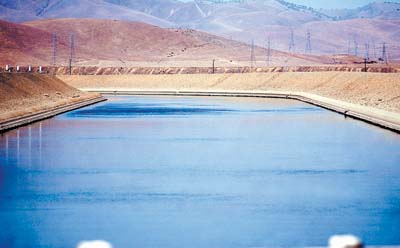
As clouds finally parted this week after bringing rainfall
amounts to at or above normal levels throughout the state, local
water officials said supplies for agricultural, municipal and
industrial uses will be more plentiful than last year.
As clouds finally parted this week after bringing rainfall amounts to at or above normal levels throughout the state, local water officials said supplies for agricultural, municipal and industrial uses will be more plentiful than last year.
“For us, it’s a good year; we’re happy,” said Jeff Cattaneo, director of the San Benito County Water District. “Water storage is looking good and there haven’t been any new pumping restrictions. San Luis Reservoir is full – and that’s good – and the reservoirs we rely upon in the Central Valley Project, like Shasta and Folsom, are all full and releasing water to maintain the flood storage they need.”
While the supplies are plentiful, “it’s getting it through the Delta” that remains an issue, Cattaneo said. Court cases in recent years have limited the amount of water that can be delivered south of the Sacramento region, with environmental groups saying the pumping affects threatened or endangered fish species while farmers say food supplies and their livelihood are affected by water-use restrictions.
Federal officials last week increased water delivery forecasts as a result of the wet winter and spring, with contractors who buy water from the federal government promised near-normal deliveries this year. However, farmers south of the Sacramento-San Joaquin Delta – such as those in San Benito County – are promised just a 5 percent increase, to 55 percent of contracted amounts.
“It’s how you define normal,” Cattaneo said. “The ‘new normal’ would be the best way to describe it. We’re south-of-Delta contractors. The folks north of the Delta are getting 100 percent of their allocations because they don’t have the pumping restrictions we have.”
Municipal and industrial water users are expected to receive 80 percent of their historical use amounts from federal sources, but just 40 percent of their contracted amounts.
“Water storage is looking good,” Cattaneo said. “It’s getting it through the Delta. If this had been five years ago (before the court cases) we’d probably be getting 100 percent of our allocation right now.”
All San Benito County reservoirs are full, with Hernandez Reservoir near Paicines flowing over its spillway into the San Benito River over the past couple of weeks.
“I think we’re looking really good locally,” Cattaneo said. “I don’t see any issues here at all.”
Snow melt is expected to keep lakes and reservoirs around the state full, meaning supplies should be ample through the start of the next rainy season.
“We’re trying to do everything we can to keep local reservoirs full to maintain as much water as we can year-to-year,” he said. “We’ll have a lot of storage going into the fall. Things are better this year than they were last year and last year they were better than the year before that. We know, though, that it’s not always going to be this way.”
The water district is planning ahead by keeping local underground aquifers full and banking water in the Central Valley.









